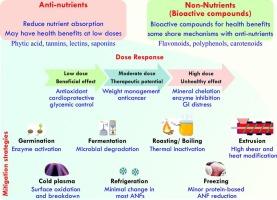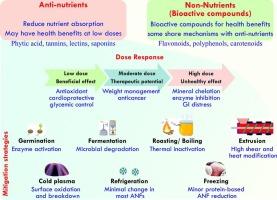Anti-nutritional factors: Nutrient interactions, processing interventions, and health aspects
IF 9.8
1区 农林科学
Q1 CHEMISTRY, APPLIED
引用次数: 0
Abstract
Plant-based foods are valuable sources of essential minerals and macronutrients. However, their bioavailability is significantly affected by anti-nutritional factors (ANFs), which can reduce nutrient intake, hinder digestion, and decrease metabolic utilization of feed. Hence, this review aims to provide comprehensive insight into various aspects of ANFs in food, including their background and interaction mechanisms with nutrients (mineral chelation, enzyme inhibition, and intestinal barrier disruption). The effectiveness of different conventional and novel technologies for reducing ANFs has been thoroughly discussed, and their limitations have been highlighted. For example, soaking typically reduces phytic acid content by 20–40 %, whereas germination and fermentation can achieve 40–80 % reduction. Extrusion and cold plasma have been reported to lower the contents of tannins and trypsin inhibitors by more than 80 % under optimized conditions. This study also explores the impact of ANFs on nutrient bioavailability and highlights dietary strategies and biological activities after the consumption of ANF-rich foods.


抗营养因子:营养相互作用、加工干预和健康方面
植物性食物是必需矿物质和大量营养素的宝贵来源。然而,它们的生物利用度受到抗营养因子(ANFs)的显著影响,可以减少营养摄入量,阻碍消化,降低饲料的代谢利用率。因此,本文旨在全面了解食品中ANFs的各个方面,包括它们的背景和与营养物质的相互作用机制(矿物质螯合作用、酶抑制作用和肠屏障破坏)。本文深入讨论了各种传统技术和新技术在减少ANFs方面的有效性,并强调了它们的局限性。例如,浸泡通常降低植酸含量20-40 %,而发芽和发酵可以达到40-80 %的降低。据报道,在优化的条件下,挤压和冷等离子体使单宁和胰蛋白酶抑制剂的含量降低了80% %以上。本研究还探讨了anf对营养物质生物利用度的影响,并强调了食用富含anf的食物后的饮食策略和生物活性。
本文章由计算机程序翻译,如有差异,请以英文原文为准。
求助全文
约1分钟内获得全文
求助全文
来源期刊

Food Chemistry
工程技术-食品科技
CiteScore
16.30
自引率
10.20%
发文量
3130
审稿时长
122 days
期刊介绍:
Food Chemistry publishes original research papers dealing with the advancement of the chemistry and biochemistry of foods or the analytical methods/ approach used. All papers should focus on the novelty of the research carried out.
 求助内容:
求助内容: 应助结果提醒方式:
应助结果提醒方式:


